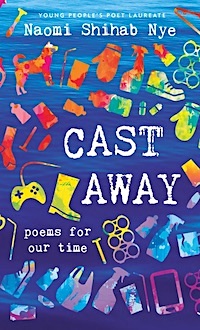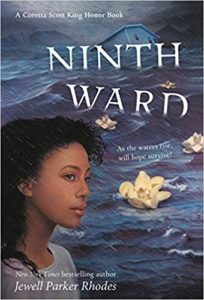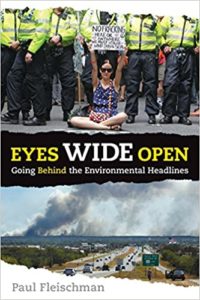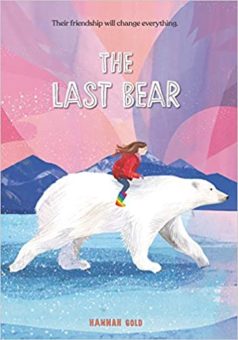Exploring the Human Impact of Climate Change
By Kasey Short

As our middle level kids delve into these texts, they develop understanding and empathy for individuals and communities impacted by climate change, and discover how to advocate for climate justice.
Exploring Climate Change Stories
I use the essential question “What can we learn about humanity from literature?” as a yearlong framework for students in my ELA classses. Exploring fictional texts that address climate changes provides the context for making connections between climate science, fictional characters, and the impact of climate change in our world today.
Reading a variety of texts (including short stories, novels, picture books and poetry) illustrates the human cost of climate change through effects such as: extreme weather, climate refugees, deforestation, destruction of ecosystems, and drought.
As my students read and examine texts, they keep a running list of notes in a graphic organizer of their choice. They can also use this chart to organize their findings.
Beginning by reading aloud a common text, such as a poem or picture book, increases engagement, allows for modeling, and gives students common examples to draw from during discussions.

A few picture books that I recommend for read aloud are The Lonely Polar Bear by Khoa Le, Our House Is on Fire: Greta Thunberg’s Call to Save the Planet by Jeanette Winter, One Plastic Bag: Isatou Ceesay and The Recycling Women of the Gambi by Miranda Paul, and We are Water Protectors by Carole Lindstrom.

I suggest providing students a list of recommended books such as Dry by Neal Shusterman & Jarrod Shusterman, Bayou Magic and Ninth Ward by Jewell Parker Rhodes, Same Sun Here by Silas House & Neela Vaswani, Love in the Time of Global Warming by Francesca Lia Block, The Last Wild by Piers Torday, and Forest World by Margarita Engle. Invite them to discover and choose a different novel if it also addresses impacts of climate change.
Suggested Discussion Questions for Stories:
1. How does climate impact the characters in the story?
2. Describe the main character’s relationship with nature?
3. How does the setting (specifically the climate) compare to where you live?
4. What (if any) role does the media play in the story?
5. How does society impact the individuals?
6. What role does community play in the story?
7. Describe a time when a character gave or received help.
8. What would climate justice look like for the character in your story?
Nonfiction Connections

A few nonfiction books students could use as resources are Eyes Wide Open: Going Behind the Environmental Headlines by Paul Fleischman, Rising Seas: Flooding, Climate Change and Our World by Keltie Thomas, Heroes of the Environment: True Stories of People Who are Helping Protect Our Planet by Harriet Rohmer, and Climate Change: The Science Behind Melting Glaciers and Warming Oceans by Josh Sneideman and Erin Twamley, published by Nomad Press.
This informal research asks students to practice research skills, reinforces the importance of checking the credibility of sources, and provides facts to ground the stories.
Advocating for Climate Justice
After reading, analyzing, discussing, and synthesizing fiction and nonfiction texts about climate change, my students decide how they would like to advocate for climate justice. To begin this process, students review their notes and then discuss the questions below with their peers.
► Is climate justice achievable?
► How does climate change impact humanity today?
► How do you think climate change will impact humanity in the future?
► Which story impacted you the most and why?
► How can you turn your understanding and compassion into action?
After the discussion students complete a writing sprint where they spend 5-6 minutes responding to the prompt, “If you had 2 minutes to speak to the entire world about the human impact of climate change, what would you want to say?” This helps narrow the focus of their project by determining what is most important to them.
Students then craft a climate justice statement that sums up their ideas about the human impact of climate change. This statement will serve as a thesis as they decide how they would like to use their voice to impact change. Using the statement as their focus, students choose an authentic audience to write for, as well as the format that would be most appropriate for that audience.
Authentic Audience Ideas: Community Leader, Peers, School Administration, Parents, Elementary School Students, Company/Community Stakeholder
Format Ideas: Poster, Elevator Pitch, Visual Presentation, Commercial, Podcast, Video, Letter, Slam Poem, Short Story, Comic Strip, Picture Book
Resource: Larry Ferlazzo has a growing collection of student climate change action videos.
Depending on the product, students use quotes, images, examples, stories, ideas, research, and photos to support their statement. After drafting, revising, and editing their work, students share their ideas with their intended audience.
While I’ve presented this as a unit for English Language Arts class, the opportunity for an ELA/Science cross-curricular partnership is definitely worth exploring.
UPDATE: I recently had the opportunity to read an advance copy of The Last Bear by Hannah Gold and it is an ideal climate fiction book for middle grades students. It tells the story of a middle grades girl, April, who travels to Bear Island in Norway for her father to conduct scientific research.

As a middle grade teacher, I love that the book encourages kids to consider what they can do to help improve our plant. My favorite quote from the book is, “But imagine if every single person on the planet just does one thing.” I think this quote alone has the potential to spark a multitude of conversations with students and help them begin exploring how they can be a voice for climate justice.
The Last Bear is available for preorder now. It’s perfect for book clubs and a must-have for classroom libraries. I recommend it for English and science teachers in grades 3-5 and it would be a great middle school read aloud (See my Edutopia article, Reading Aloud to Middle School Students). I cannot wait to share it with my students in a few months!
Kasey Short (@shortisweet3) attended the University of North Carolina at Chapel Hill and earned a bachelor of arts in middle school education with a concentration in English and history. She went on to earn a master’s in curriculum and instruction from Winthrop University. She is currently an eighth grade English teacher as well as English Department chair at Charlotte (NC) Country Day School.



































